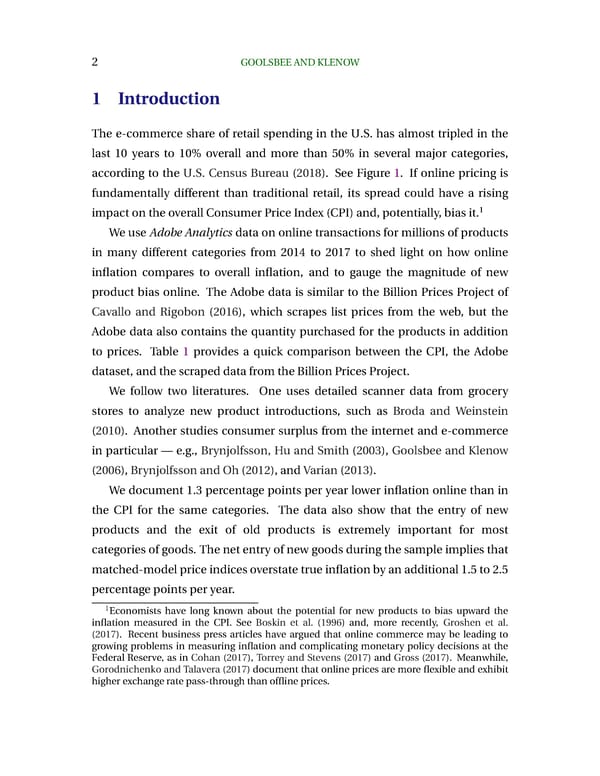2 GOOLSBEEANDKLENOW 1 Introduction The e-commerce share of retail spending in the U.S. has almost tripled in the last 10 years to 10% overall and more than 50% in several major categories, according to the U.S. Census Bureau (2018). See Figure 1. If online pricing is fundamentally different than traditional retail, its spread could have a rising 1 impactontheoverallConsumerPriceIndex(CPI)and,potentially,biasit. WeuseAdobeAnalytics dataononlinetransactionsformillionsofproducts in many different categories from 2014 to 2017 to shed light on how online inflation compares to overall inflation, and to gauge the magnitude of new product bias online. The Adobe data is similar to the Billion Prices Project of Cavallo and Rigobon (2016), which scrapes list prices from the web, but the Adobe data also contains the quantity purchased for the products in addition to prices. Table 1 provides a quick comparison between the CPI, the Adobe dataset, andthescrapeddatafromtheBillionPricesProject. We follow two literatures. One uses detailed scanner data from grocery stores to analyze new product introductions, such as Broda and Weinstein (2010). Another studies consumer surplus from the internet and e-commerce in particular — e.g., Brynjolfsson, Hu and Smith (2003), Goolsbee and Klenow (2006), Brynjolfsson andOh(2012),andVarian(2013). Wedocument1.3percentagepointsperyearlowerinflation online than in the CPI for the same categories. The data also show that the entry of new products and the exit of old products is extremely important for most categoriesofgoods. Thenetentryofnewgoodsduringthesampleimpliesthat matched-modelpriceindicesoverstatetrueinflationbyanadditional1.5to2.5 percentagepointsperyear. 1Economists have long known about the potential for new products to bias upward the inflation measured in the CPI. See Boskin et al. (1996) and, more recently, Groshen et al. (2017). Recent business press articles have argued that online commerce may be leading to growing problems in measuring inflation and complicating monetary policy decisions at the Federal Reserve, as in Cohan (2017), Torrey and Stevens (2017) and Gross (2017). Meanwhile, GorodnichenkoandTalavera(2017)documentthatonlinepricesaremoreflexibleandexhibit higherexchangeratepass-throughthanofflineprices.
 Internet Rising, Prices Falling Page 1 Page 3
Internet Rising, Prices Falling Page 1 Page 3